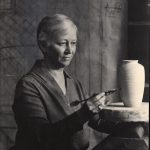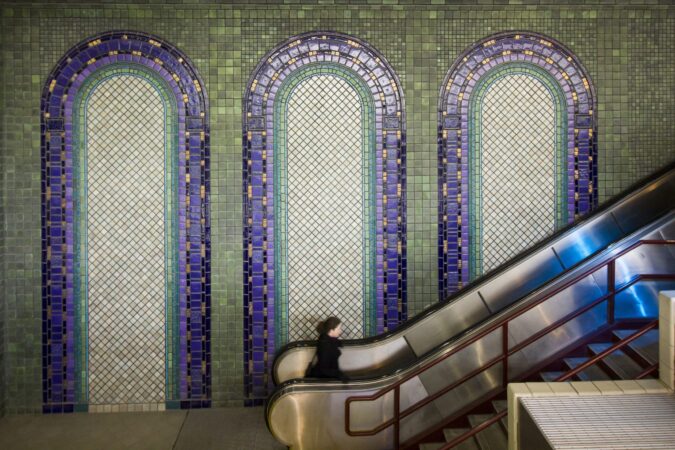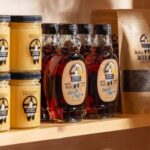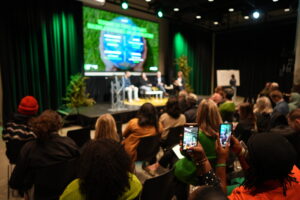Detroit is known for its industry, but did you know that the city also has a strong arts and crafts tradition?
Detroit played a significant role within the Arts and Crafts Movement in the late 19th Century – a movement dedicated to recapturing craftsmanship that many felt was being debased by mechanization in an era of industrialization.

STEVEN MCBRIDE
A shining star in Detroit within that movement was Pewabic Pottery, which today is one of the oldest continually operating potteries in the country.
Pewabic Pottery celebrated its 120th anniversary last year, having weathered a depression, two world wars, and most recently, of course, the pandemic. Its history is uniquely and intricately intertwined with Detroit, and its work is an integral part of much of the city’s architecture, including the DIA, the Q-Line, the Guardian Building, Comerica Park, Little Caesars Arena – and also many homes.

PEOPLE MOVER – CADILLAC STATION
“Pewabic is part of the fabric of the city and has grown and evolved with Detroit for over a century,” said Steve McBride, executive director. “As we’ve seen recently – thanks to the Detroit Lions – GRIT has always been a part of Detroit’s DNA – there is something cool about people putting work in with their hands to create something beautiful. That feels essential to what Detroit is.”
THE HISTORY
The Pewabic studio – an active working pottery, architectural tile studio, ceramic arts education center, and vibrant cultural destination that attracts visitors from around the world – is a historic landmark.
It was founded in 1903 by Mary Chase Perry Stratton and Horace J. Caulkins, interestingly, the same year as Ford Motor Company was founded.
Mary worked as a china painter and Horace owned a dental supply company and had developed a “Revelation kiln” used to fire porcelain teeth. Mary became interested in the kiln for her work, met with Horace, and ultimately took a job selling his kilns across the country to promote their use of firing pottery. Eventually, it was her idea to start a business with Horace.
They originally set up shop in a carriage house at the Ransom Gillis House in Brush Park, naming the company after a copper mine in Mary’s hometown of Hancock, MI. Their first big order was from the famous Chicago Department store – Burley & Co. After a few short years, they outgrew the space.

MARY CHASE PERRY STRATTON
Mary commissioned architects William Stratton and Frank Baldwin to design the “Tudor Revival” structure – a style popular within the Arts and Crafts movement. It remains operating today at 10125 E. Jefferson Ave.
Mary – who married William Stratton – ran Pewabic Pottery until the age of 94.
Upon her death, Horace’s son Henry inherited the business, and eventually in the mid-1960’s it was donated to Michigan State University. In the late 70’s MSU was prepared to close it due to financial issues, but the Pewabic Society was formed as a fundraising group to save it. Eventually, the Pewabic Society took it over as a non-profit 501c3 and that’s how it continues to operate today.
THE MISSION
About the pottery’s mission, which is ‘to enrich the human spirit through clay,’ McBride says, “The spirit of life is richer when you incorporate art. A simple example is drinking your morning coffee from a handcrafted mug. It’s a deeper experience.”
He points to homes with Pewabic tiled fireplaces, or backsplashes, saying, “These areas are more enjoyable when art is added as inspiration. It brings richness and depth and enriches everyday living.”
TODAY’S PEWABIC POTTERY
Visitors today can shop the latest designs by Pewabic and other ceramic artists in the pottery store, see architectural offerings in its tile showroom, and explore the history of the pottery and its early work in a second-floor museum. The pottery offers tile glazing workshops, tours, and other events that sell out months in advance.
When asked why he thinks the events are so popular, McBride comments, “I think there is a real hunger now for people to experience something real. In the early days, the arts and crafts movement was in response to industrialization. Now I think the interest is in response to the virtual world. People have a fundamental need to understand their world through touch and movement – through items made by real people right in their community.”
The original clay mixer installed in Installed 1912 is still in use today. It’s built into an underground tank with a huge paddle that mixes the ingredients – all driven by overhead belts. McBride says “It’s a cool sense of history seeing that mixer running today, the same mixer that turned out clay for tiles in the 1920s that embellish the Guardian Building today.”
THE FUTURE
In 2018 a 2,500-square-foot addition was added to the original building, which McBride simply says, “Allows us to do more and create more.”

PEWABIC POTTERY COURTYARD
Also in 2018, Pewabic Pottery received a grant that facilitated a courtyard facelift that’s now used for a summer market and other events. “Last year we launched a Visiting Artist Series, bringing local artists into the courtyard on Saturdays during the summer,” says McBride.
He says they are seeing more and more people interested so they are adding new workshops and tours.
In the end, McBride says, “Ultimately, Pewabic Pottery gives people a connection to the city’s rich artistic legacy of innovation, design, and simply making beautiful and unique things.”
As always, be sure to subscribe to our newsletter for regular updates on all things Detroit.






















